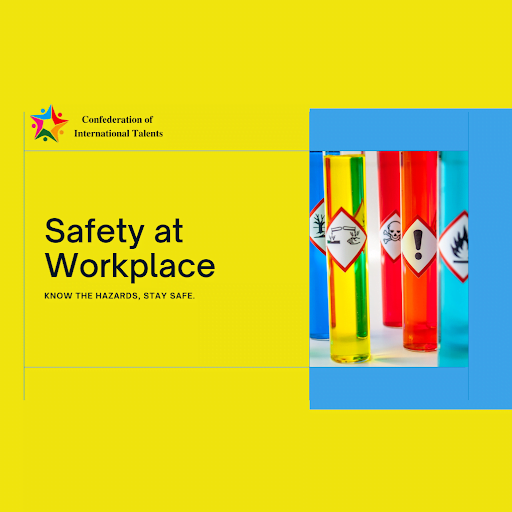
Effective Hazard Communication: Ensuring Safety in the Workplace
For any organization, safety should be the foremost focus. To protect employees and prevent accidents, it is crucial to have an effective hazard communication system in place. Hazards exist in various forms, ranging from chemical substances to physical and biological agents. Understanding these hazards and being able to communicate and mitigate their risks are essential for maintaining a safe working environment. Let us discuss the significance of effective hazard communication in the workplace, discuss communication methods for safety, and shed light on the consequences of improper hazard communication.
What Are Hazards?
There are various types of workplace hazards that employees may face while performing their job duties. These hazards can be categorized as physical, chemical, biological, ergonomic, and psychosocial.
1. Physical hazards:
These include anything that can cause harm to an employee’s body, such as slips, trips, falls, electrical hazards, machinery or equipment malfunctions, noise, vibrations, and extreme temperatures.
2. Chemical hazards
These are substances that can cause harm or injury to an employee if they are inhaled, ingested, or come into contact with the skin. These can include toxic chemicals, gases, fumes, and liquids, and may be found in cleaning products, solvents, pesticides, and other workplace materials.
3. Biological hazards:
These include exposure to viruses, bacteria, and other pathogens that can cause harm to an employee’s health. These hazards may be found in healthcare settings, laboratories, or other workplaces where employees may come into contact with bodily fluids or other contaminated materials.
4. Ergonomic hazards
These are those that can cause physical strain or injury to an employee, such as repetitive motions, awkward postures, heavy lifting, and poor workstation design.
5. Psychosocial hazards
This can include anything that can cause stress or emotional strain on an employee, such as workplace violence, bullying, harassment, and excessive workloads.
Employers have a responsibility to identify and address these hazards in the workplace to ensure the safety and well-being of their employees.
Effective Communication Methods:
To make sure the hazard information is adequately communicated to employees, the implementation of the following methods is essential:
1. Safety Data Sheets (SDS):
SDSs provide detailed information about hazardous substances, their properties, potential health effects, safe handling procedures, and emergency response measures. Employers must maintain readily accessible SDSs for all hazardous chemicals present in the workplace.
2. Labels and Signs:
Employers must label containers of hazardous substances with appropriate warning labels. It’s important to have labels on products that show any potential dangers. These labels should have symbols that warn you of the danger, words that tell you how serious it is, and instructions on how to stay safe. This way, people can easily understand what the risks are and how to avoid them. Additionally, signs and placards should be strategically placed in areas where specific hazards exist.
3. Training Programs:
Regular employee training programs are vital for effective hazard communication. Employers should conduct Occupational Health and Safety training sessions to educate employees about different hazards, associated risks, precautionary measures, and the proper use of personal protective equipment (PPE).
4. Written Hazard Communication Programs:
Employers should develop and maintain a written hazard communication program according to workplace requirements. This program should outline procedures for hazard identification, SDS management, labeling, employee training, and the overall communication process.
Consequences of Improper Hazard Communication:
Improper hazard communication can have severe consequences for both employees and employers. Some of the potential effects include:
1. Workplace Accidents:
Inadequate hazard communication increases the risk of accidents, injuries, and illnesses. Without proper knowledge of potential hazards, employees may unknowingly expose themselves to dangerous situations.
2. Health Issues:
Insufficient communication regarding hazardous substances can lead to long-term health problems. Exposure to chemicals without understanding their risks and proper handling procedures may result in respiratory issues, skin irritations, or chronic illnesses.
3. Legal Penalties:
Non-compliance with hazard communication regulations, such as those outlined by the Occupational Safety and Health Administration (OSHA), can result in legal penalties, fines, or even the closure of the workplace.
Compliance with OSHA Guidelines:
To ensure effective hazard communication, it is crucial to adhere to the respective guidelines such as OSHA. Some key OSHA requirements include:
– Hazard evaluation and identification.
– Written hazard communication programs.
– Safety data sheets (SDS) for hazardous chemicals.
– Proper labeling of containers and hazardous substances.
– Regular employee training and education programs.
Conclusion:
“An established hazard communication system is an essential component of workplace safety.” By understanding the various hazards present, employing suitable communication methods, and complying with the guidelines, employers can protect their employees and prevent accidents. Clear communication, comprehensive training, and proper implementation of safety measures will create a safer working environment for everyone.
Remember, effective hazard communication saves lives, prevents injuries, and ensures a culture of safety within the workplace. To create a safe environment it is important to have regular OHS training to keep your employees updated on safety needs. For qualitative training, contact the Confederation of International Talents (CIT) today!
